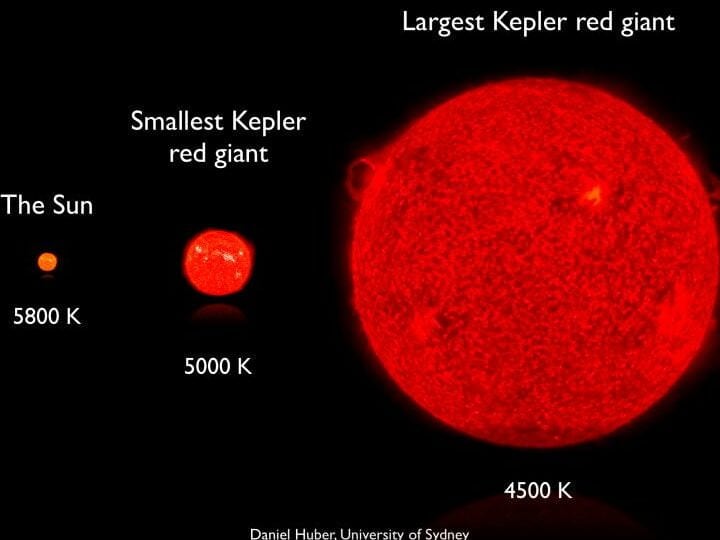
Currently, a total of 58,747 educational establishments are providing extra cumulative reductions (ranging from 2% to 25%). To determine the applicable discount for all staff members at your educational institution, please access your personal Infoworks account.


Are you looking to enhance your skills in the field of Informatics? Our professional retraining course, “Informatics: theory and methodology of teaching in vocational education,” is designed to provide you with the knowledge and tools you need to excel in this area.
As an added bonus, we offer discounts to educational institutions. If multiple colleagues from your institution have taken Infowrok courses, we can add your institution’s discount to this offer. The amount of the discount depends on the number of colleagues who have participated.
Currently, 58,747 educational institutions are benefiting from additional discounts ranging from 2% to 25%. To find out what discount is applicable to all employees at your institution, simply log in to your personal Infoworks account.


Advanced training program
Utilization of MS Word and Excel for financial computations
We have the ability to incorporate the discount provided by your educational institution (which is contingent upon the number of your colleagues who have enrolled in Infoworks courses)
Currently, 58,747 educational institutions are benefiting from supplementary discounts (ranging from 2% to 25%). To ascertain the discount that is accessible for all faculty members of your educational institution, kindly access your personal Infoworks account.


Creating a Productive Environment for Children with Disabilities and Their Parents
Overview of the Presentation by Individual Slides:

A red giant is a term used in astronomy to describe large stars with late spectral classes that have high luminosity and extended envelopes. Some examples of red giants are Arcturus, Aldebaran, and Hakruks, which are part of the red giant branch.
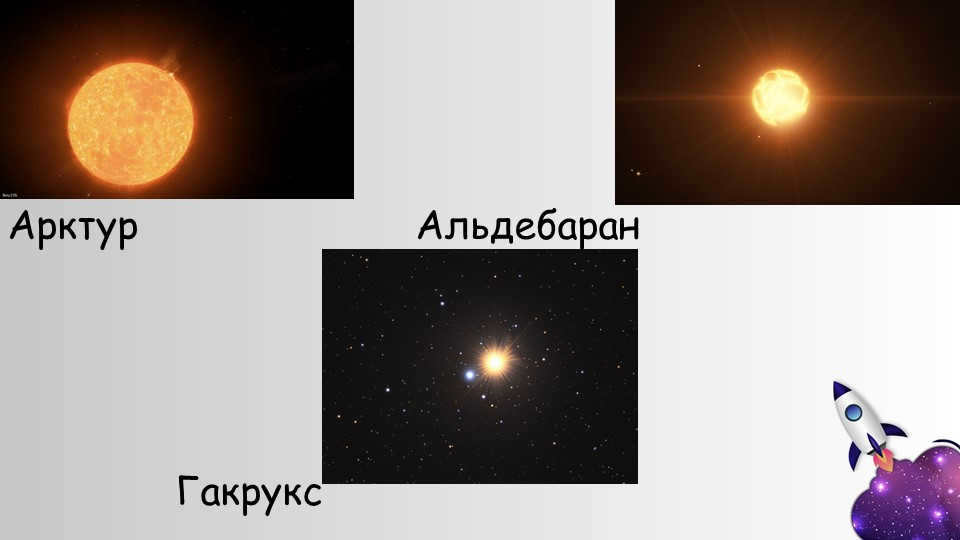
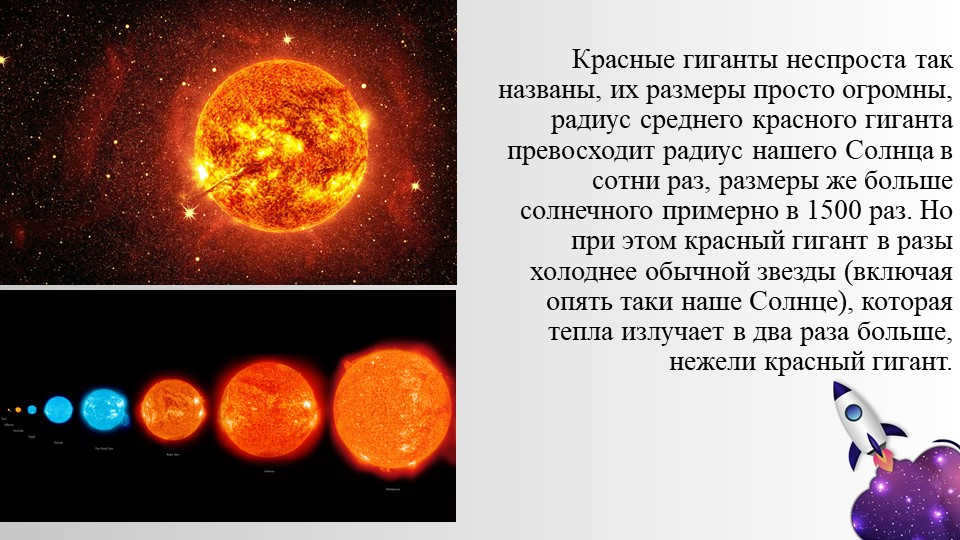
Red giants earned their name due to their immense size. The average red giant has a radius hundreds of times larger than our Sun, making it about 1500 times bigger in size. However, despite its massive size, a red giant is much colder than a regular star, including our Sun, which emits twice as much heat as a red giant.
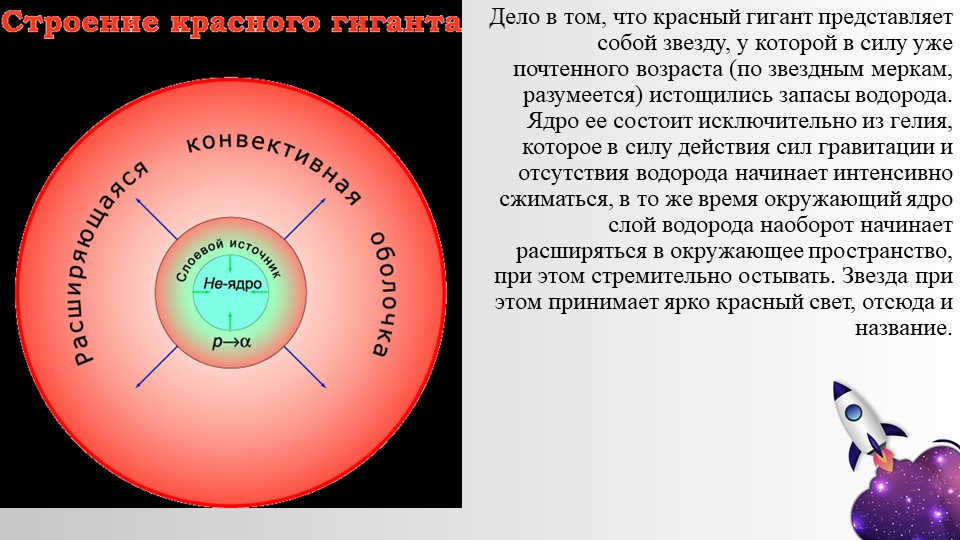

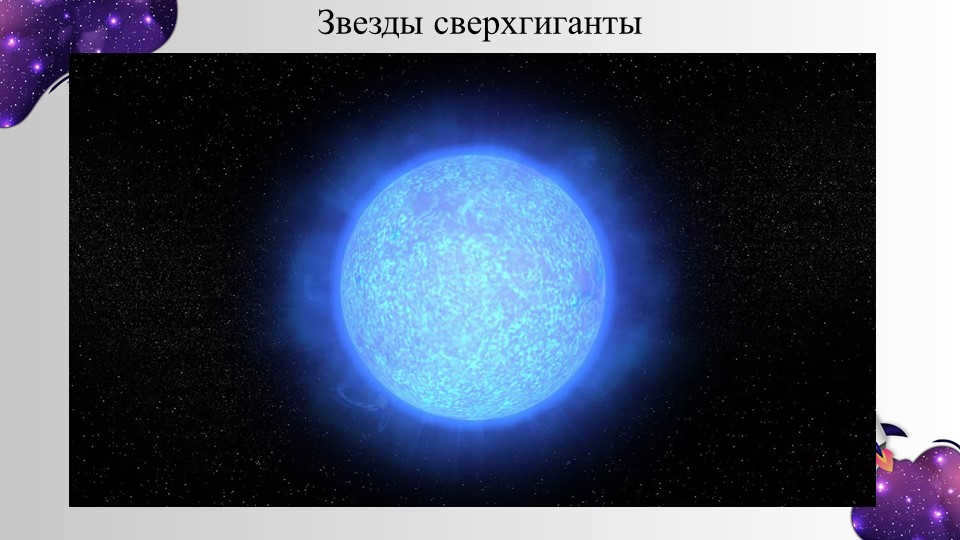
The formation of stars is heavily influenced by mass – a larger core produces more energy, leading to higher temperatures and increased activity in the star. As they near the end of their lifespan, objects with a mass between 10 and 70 times that of the Sun become supergiants.
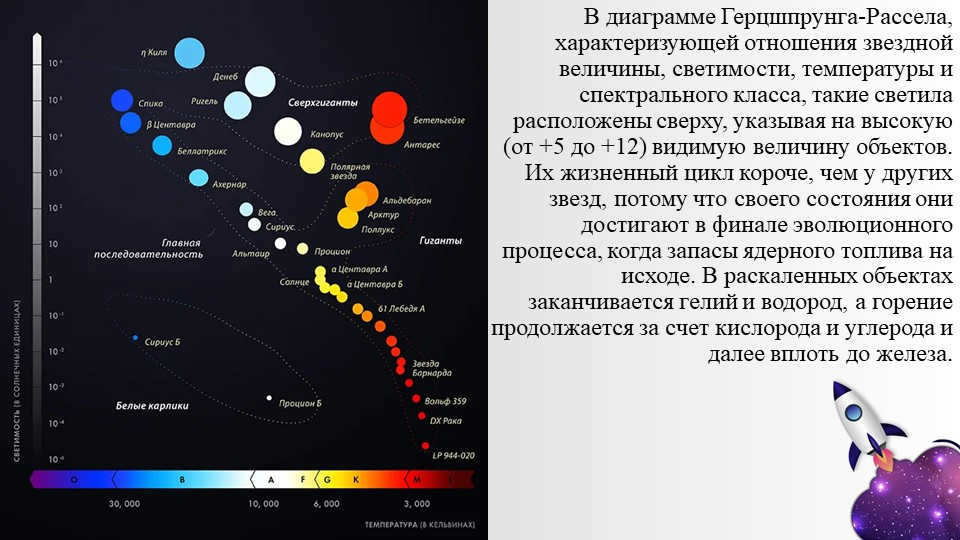

The Hertzsprung-Russell diagram is a representation of the relationships between stellar magnitude, luminosity, temperature, and spectral class. In this diagram, the red giants are positioned at the top, indicating their high apparent magnitude (+5 to +12). These stars have a shorter lifespan compared to other stars because they reach this stage at the end of their evolutionary process, when their nuclear fuel reserves are depleted. As a result, helium and hydrogen are exhausted in these luminous objects, and combustion continues with the utilization of oxygen, carbon, and eventually iron.
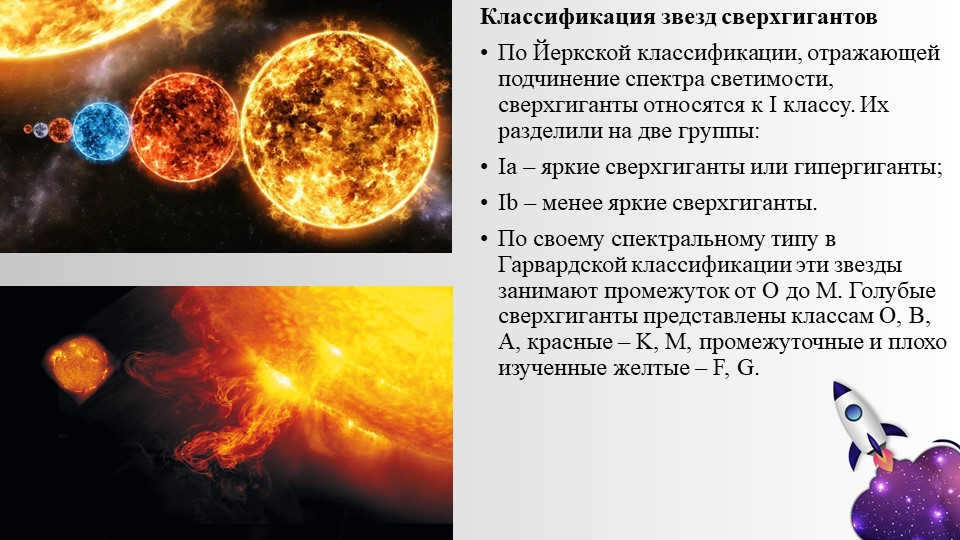
Supergiant stars can be classified according to the Yerkes classification system, which categorizes them based on their luminosity spectrum. According to this system, supergiants are placed in Class I. Within this class, supergiants are further divided into two groups:
Ia – which includes the bright supergiants or hypergiants;
Ib – which includes the less bright supergiants.
In terms of their spectral type, supergiants span the range from O to M according to the Harvard classification system. Blue supergiants fall into the O, B, and A classes, while red supergiants are categorized as K and M. The yellow supergiants, which are less studied, fall into the intermediate and poorly studied F and G classes.
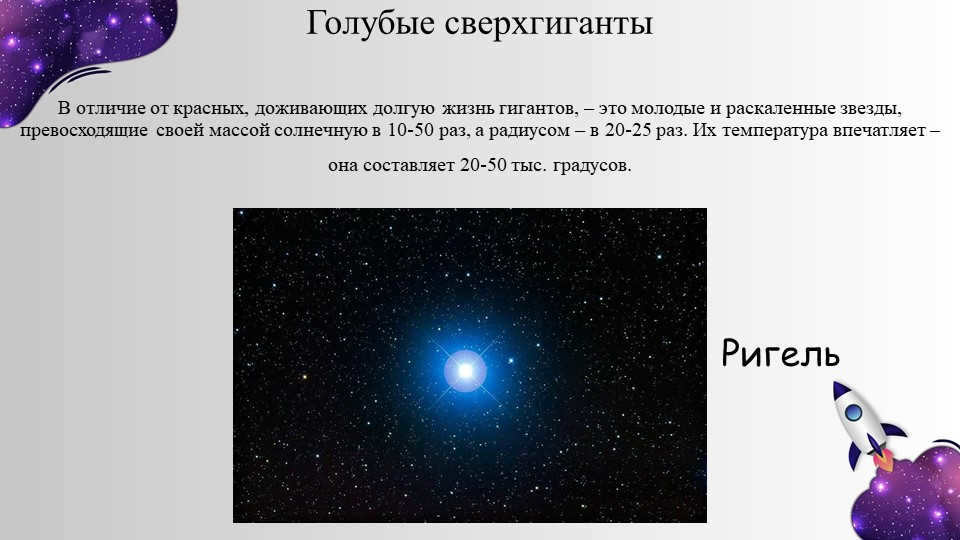
Slide number 10: Blue supergiants
Unlike the red giants, which have long lifespans, these stars are young and extremely hot, with a mass 10-50 times greater than the sun and a radius 20-25 times larger. They have an impressive temperature range of 20-50 thousand degrees.
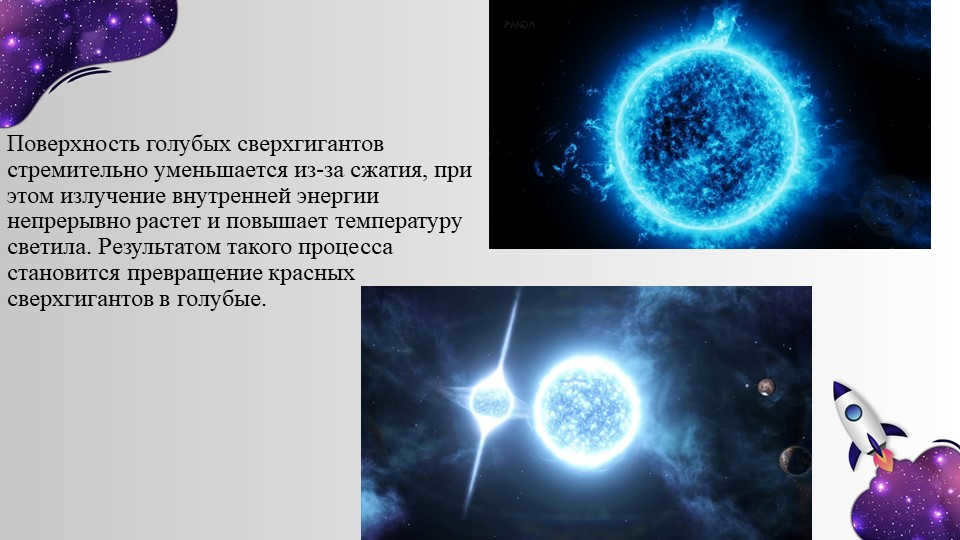
The surface area of blue supergiants is quickly diminishing as a result of compression, while the emission of internal energy is continuously expanding and raising the temperature of the star. This phenomenon leads to the conversion of red supergiants into blue supergiants.
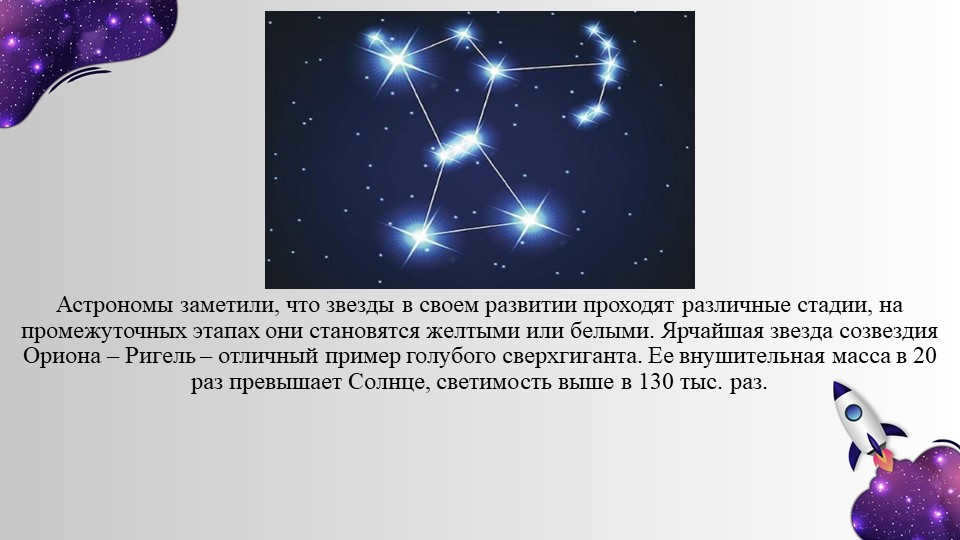

Astronomers have observed that stars undergo various phases during their evolution, transitioning through intermediate stages where they appear yellow or white. Rigel, the brightest star in the constellation of Orion, serves as a prime example of a blue supergiant. With a mass 20 times that of the Sun and a luminosity 130 thousand times greater, it stands as an impressive celestial body.
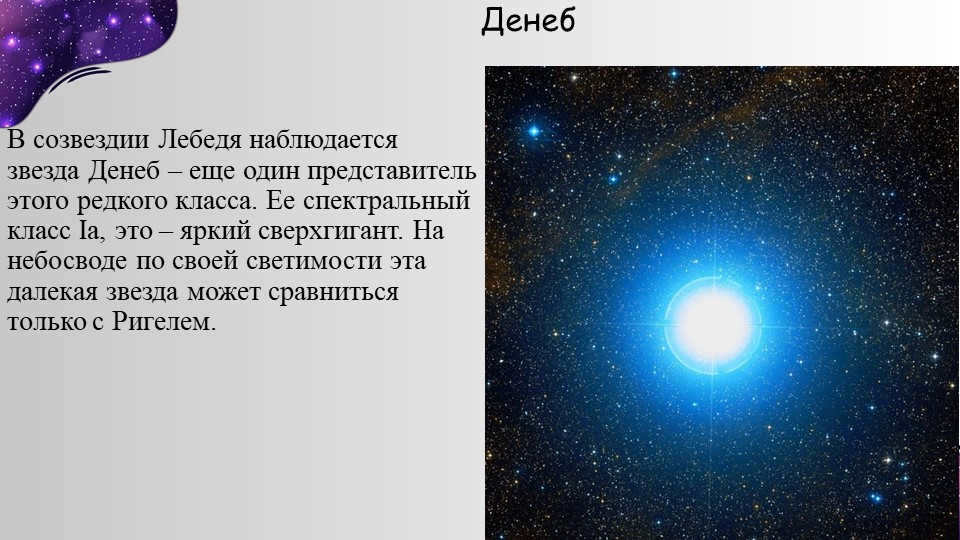
The constellation of Swan contains a star called Deneb, which belongs to the group of red giants. Deneb has a spectral class of Ia and is classified as a bright supergiant. In terms of its luminosity, this distant star can only be compared to Rigel.
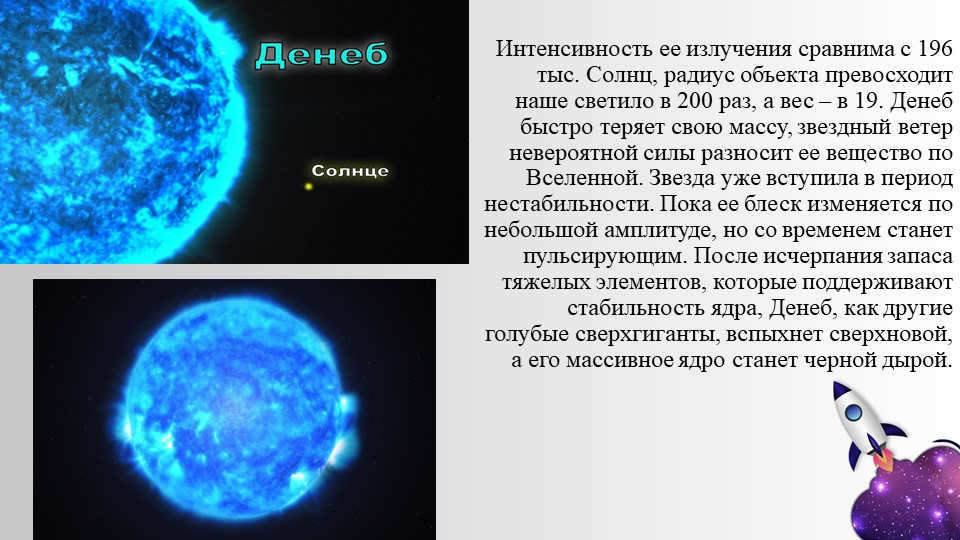
The intensity of the radiation emitted by Deneb is equivalent to that of 196 thousand suns, with its radius surpassing our own sun by 200 times, and its weight by 19 times. Deneb is currently undergoing a rapid loss of mass, as its stellar wind propels its matter throughout the vast expanse of the Universe. This star has already entered a phase of instability, although its luminosity is presently experiencing only slight fluctuations. However, over time, it is anticipated that Deneb will transition into a pulsating state. Once its supply of heavy elements, which help to maintain the core’s stability, is depleted, Deneb, like other blue supergiants, will undergo a supernova event, and its massive core will ultimately collapse into a black hole.
Discover a wide range of educational materials for any lesson by selecting your subject, grade level, textbook, and topic:
There are currently 6,330,940 materials available in our database.
These materials are specifically designed for teaching purposes:
Subject
Additional Materials
- Textbook: “Astronomy (basic level)”, authored by Vorontsov-Vel’yaminov BA and Straut E.K.
- Topic: Exploring the field of astronomy, its importance, and its connections to other sciences
- Textbook: “Astronomy (basic level)”, authored by Vorontsov-Veliaminov B.A. and Straut E.K.
- Topic: Chapter 1 – An introduction to the subject of astronomy
- Textbook: “Astronomy (basic level)”, authored by Vorontsov-Vel’yaminov B.A. and Straut E.K.
- Topic: Chapter 19 – Exploring distant planets
You may find these courses interesting:
- Retraining course for professionals in “Transport Logistics Organization”
- Professional Development Course on “Business Communication Ethics”
- Professional Development Course on “Organizing Student Internships to Meet the Requirements of the Federal State Standard of Medical Education”
- Advanced training course on “Teaching Astronomy in Secondary Schools: Special Considerations”
- Professional Development Course on “Insurance and Actuarial Calculations”
- Retraining course for professionals in “Astronomy: Teaching Theory and Methodology in Educational Institutions”
- Advanced training course on “Modern Modeling Methods and Tools”
- Retraining program for professionals: “Effective assistance to top executives with knowledge of foreign languages”
- Professional course: “Enhancing the role of executive secretaries with proficiency in English”
- Specialized program: “Maintenance and operation of shared facilities in residential buildings”
- Management training: “Effective hotel management and current operations”
- Advanced course: “International financial and credit relations”
- Retraining program: “Mastering quality management techniques”
Leave your feedback
If you think that the content infringes copyright or should be removed for any other reason, you can submit a complaint regarding the content. Delete content.
Author of the content
- On the website: 2 years and 6 months
- Subscribers: 0
- Total views: 10834
- Total content: 7
Posted 56 minutes ago
Posted 45 minutes ago
Posted 52 minutes ago
Users who post materials on the site are responsible for resolving any disputes regarding the materials and their content. However, the site administration is willing to provide assistance in resolving any issues related to the site’s work and content. If you come across any unauthorized use of materials on this site, please notify the site administration through the feedback form.
All materials on the site are either created by the site’s authors or submitted by its users, and are provided for reference purposes only. The copyrights to these materials belong to their respective authors. Any partial or full copying of site materials without written permission from the site administration is strictly prohibited! The views expressed by the administration may not necessarily align with those of the authors.
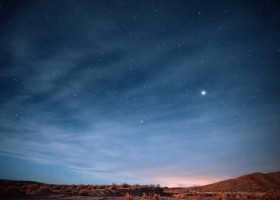
The following article will provide you with information about the nature of stars and the various types that exist. Additionally, it will explore the size of our Sun in comparison to other stars.
With the exception of the Moon and the planets, any seemingly immobile object in the sky is a star, a source of thermonuclear energy. Stars come in a range of sizes, from dwarfs to supergiants.
Although the Sun is a star, its brightness and size are magnified due to its proximity to Earth. In contrast, most stars appear as tiny, luminous dots even when observed through powerful telescopes. However, we have acquired some knowledge about them. For instance, we understand that stars vary in size and that at least half of them consist of two or more stars gravitationally bound together.
What is a star?
A star is a massive celestial object composed primarily of hydrogen and helium, along with small amounts of other elements. The force of gravity pulls the matter inward, while the pressure from the heated gas pushes it outward, resulting in a delicate balance. The core of a star is where its energy is generated, as millions of tons of hydrogen are fused into helium every second. Despite this ongoing process occurring in the Sun’s core for nearly 5 billion years, only a minute portion of its hydrogen reserves have been consumed.
Classification of stars
Main-sequence stars, also known as dwarf stars, can be classified based on their luminosity and surface temperature. In the early 20th century, Dutch astronomer Einar Hertzsprung and American astronomer Henry Norris Russell developed the Hertzsprung-Russell (HR) diagram. This diagram plots the luminosity of a star against its surface temperature, allowing us to determine the distance to the stars.
The majority of stars, including our own Sun, are located within a specific region of the HR diagram known as the main sequence. This band of stars extends diagonally across the diagram. Although they are referred to as dwarfs, some main-sequence stars can be up to 20 times larger than the Sun and emit light that is 20,000 times brighter.
Red dwarfs
Red dwarfs, the most prevalent type of stars, are found at the cool and dim end of the main sequence. These stars are smaller than the Sun and have the ability to conserve their fuel reserves, enabling them to extend their lifetimes by tens of billions of years. If we were able to view all red dwarfs, the sky would be filled with countless tiny dots. However, red dwarfs emit such a faint light that we can only observe those that are nearest to us, like Proxima Centauri.
White dwarfs
White dwarfs, which are even smaller than red dwarfs, have a size comparable to that of Earth. However, their mass can be as large as that of the Sun. To put it into perspective, if you were to have a volume of white dwarf matter equivalent to the volume of this book, it would weigh approximately 10 thousand tons! When examining their position on the GR diagram, it becomes evident that white dwarfs are distinct from red dwarfs due to their depleted nuclear source.
Red giants are the second most abundant type of stars after main sequence stars. While they have a similar surface temperature to red dwarfs, red giants are much larger and brighter, causing them to be positioned above the main sequence on the HR diagram. Although their mass is typically similar to that of the Sun, if a red giant were to replace our Sun, the inner planets of our solar system would be engulfed by its atmosphere.
Supergiants
At the top of the GR diagram are the incredibly rare supergiants. Betelgeuse, located in Orion’s shoulder, spans a staggering distance of almost 1 billion kilometers. Another notable star in the Orion constellation is Rigel, which is one of the most luminous stars visible to the naked eye. While Rigel is about ten times smaller than Betelgeuse, it is still nearly 100 times larger than our Sun. 
Throughout history, stars have captivated humanity with their enchanting beauty and enigmatic nature. However, to the untrained eye, they may simply appear as indistinguishable points of light in the night sky. In reality, stars vary in size, color, brightness, and lifespan. Our new publication, “Cosmos. Encyclopedia,” aims to provide a comprehensive understanding of these celestial wonders. Are you ready to embark on this cosmic journey?
A luminous mass of gas
A stellar object is an immense luminous mass of gas, predominantly composed of hydrogen. Its nucleus generates an astonishing quantity of energy. Escaping from the star’s interior, this energy disperses into space in the form of light, heat, and other imperceptible forms of radiation. Due to the vast amount of energy emitted, stars exhibit such brilliance and high temperature.
Stars exhibit variations in magnitude, but their structure remains consistent. Each star possesses a scorching central region, known as the core, where energy is generated; one or more layers of gas where energy is transferred; a heated surface; and an atmosphere. Our sun is an average star that appears larger to us solely because of its proximity.
Stellar stability
Everyday stars, like the Sun, maintain a state of stability. This implies that their dimensions, mass, and brightness rarely experience any changes. Whenever this equilibrium is disrupted, the star has the potential to transform into either a red giant or a black hole.
- In a typical star, the pull of gravity towards the center is balanced by the outward force of gas pressure.
- Once hydrogen is depleted in the star’s core and helium ignition takes place, the outward pressure intensifies, leading the star to expand and become a red giant.
- When a massive star reaches the end of its life, gravity causes its core to collapse, resulting in the formation of a black hole.
That’s quite a distance. But just how far?
Every star, with the exception of our own Sun, is located at an incredibly vast distance from Earth. This is precisely why they only appear to us as tiny, bright specks in the night sky. To measure these immense distances, scientists have introduced a specialized unit known as the light year (abbreviated as “ly”). A light year is the distance that light can travel through a vacuum within the span of one year. This equates to approximately 9.5 trillion kilometers. For instance, the closest star to our Sun, Proxima Centauri, is located at a distance of about 4.2 light years.
Classification of Stars
Astronomers categorize stars based on their color, size, and luminosity. The smallest stars, known as dwarfs, have a volume less than one thousandth of the Sun’s. On the other hand, the largest stars have a volume that exceeds the Sun’s by a factor of eight billion and are billions of times brighter than the smallest stars. The characteristics of a star primarily depend on its mass, which determines its brightness and temperature. However, higher mass stars have shorter lifetimes as their fuel is consumed more rapidly.
- Old stars that have reached the end of their lives are the largest stars. These giants can be up to 200 times larger than the Sun and thousands of times brighter. Furthermore, supergiants and hypergiants can be up to 2000 times larger than the Sun and a billion times brighter.
The origin of stars
Stars originate from frigid molecular clouds. The process of star formation is initiated by external factors such as a supernova explosion or a celestial collision with another star.
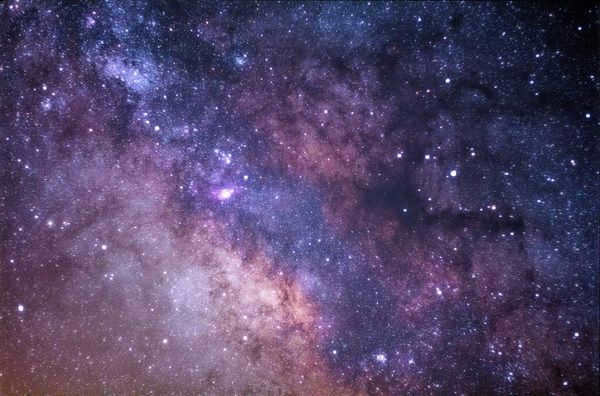
Stars, like all things in our world, have a beginning and an end. – Source
Here are the stages in the formation of a new star:
- Formation of a clump. Within a cold gas and dust cloud, clumps of gas start to form.
- Clump compression. As the clump compresses, the gas cools down by emitting energy into space. Gravity causes the clump to contract and attract more gas.
- Development of a spinning disk. Once the clump can no longer radiate energy into space, it heats up and a disk of matter forms around it. Jets of gas are ejected along the disk’s axis.
- A celestial body ignites. Once the temperature at the core of the nebula reaches a scorching 3-4 million degrees Celsius, a thermonuclear reaction is triggered – giving birth to a star. Meanwhile, the remaining matter gravitates around this luminous entity.
- The gaseous debris disperses. The intense radiation emitted by the newly formed star pushes away the remnants of the nebula from which it emerged. Over time, these dispersed particles coalesce into dense clusters, ultimately forming planets that settle into their own orbits.
Planets beyond the Solar System
Exoplanets are celestial bodies that revolve around stars located outside of our own solar system. These planets vary in size and temperature, and some even have a dual star system. Scientists speculate that there may be as many as 11 billion exoplanets similar to Earth that could potentially support life in our Milky Way galaxy.
Scorching Giants
A significant number of exoplanets are known as hot Jupiters. These gas giants are similar in size to Jupiter or even larger, but they are much hotter due to their close proximity to their host stars.
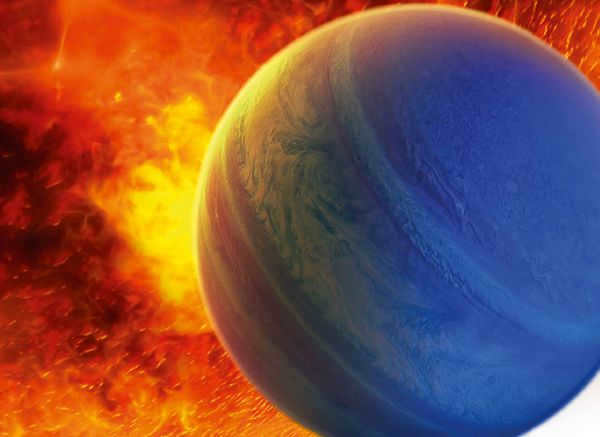
The temperature on the surface of the most scorching hot Jupiter surpasses 2000 °C. – Picture from the publication
Hot Jupiters have orbits that span from 2 to 75 million kilometers away from their respective stars. Due to this close proximity, hot Jupiters experience extreme weather conditions: intense winds, temperatures high enough to liquefy metal, and showers of glass. Their destiny is unfortunate: some are engulfed by their own parent stars. Others burn out, leaving only a rocky or metallic nucleus behind.
At the point when a red supergiant can no longer generate energy through thermonuclear fusion, it undergoes a massive supernova explosion. The external layers of the star are completely vaporized and dispersed into the surrounding space, while the core undergoes a process of inward collapse. The final outcome is determined by the mass of the core, which can either result in the formation of a neutron star or the creation of a black hole.
A neutron star
After a supernova explosion, a star with a mass 10-20 times that of the Sun undergoes a transformation into a neutron star. This incredible celestial object is the highly compressed core of a massive star, representing the final stage before collapsing into a black hole. Despite its immense gravitational force, something within the neutron star prevents its outer layers from collapsing inwards and forming a black hole.
Neutron stars are incredibly dense, with a tiny speck of their matter weighing twice as much as the largest supertanker on Earth. These celestial bodies also rotate at astonishing speeds, with some completing up to 700 revolutions per second. As they spin, they emit a distinctive glow, although this light only reaches Earth in intermittent bursts. This is why neutron stars often appear to twinkle from our perspective. Neutron stars that exhibit this flickering behavior are known as pulsars.
Study of Black Holes
Black holes remain one of the most enigmatic phenomena in the cosmos. With their immense gravitational pull, these celestial objects possess the ability to trap even light within their boundaries, rendering them impenetrable to any form of escape.
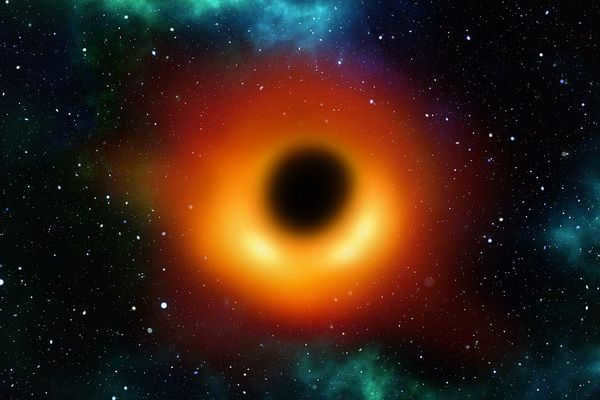
It is estimated that there may be tens of millions of black holes within the Milky Way galaxy. – Source
Black holes are typically formed when a massive star exhausts its fuel and undergoes a supernova explosion. The immense gravitational force causes the star’s core to collapse rapidly, shrinking to a size smaller than an atom in a mere fraction of a second, resulting in a singularity. A singularity is an infinitesimally small object with infinite density. Anything in close proximity to the singularity will be irresistibly drawn towards it by the force of gravity, vanishing without a trace. Surrounding the singularity is a spherical boundary known as the event horizon. Once an object crosses this boundary, it is impossible for it to escape the gravitational pull of the black hole and return.
There are numerous additional facts about space, both well-known and obscure, that can be found in this encyclopedia. It covers a wide range of topics including the solar system, galaxies, and technology. The goal is to provide a better understanding of these subjects.
The image on the post’s cover features an illustration taken from the book.
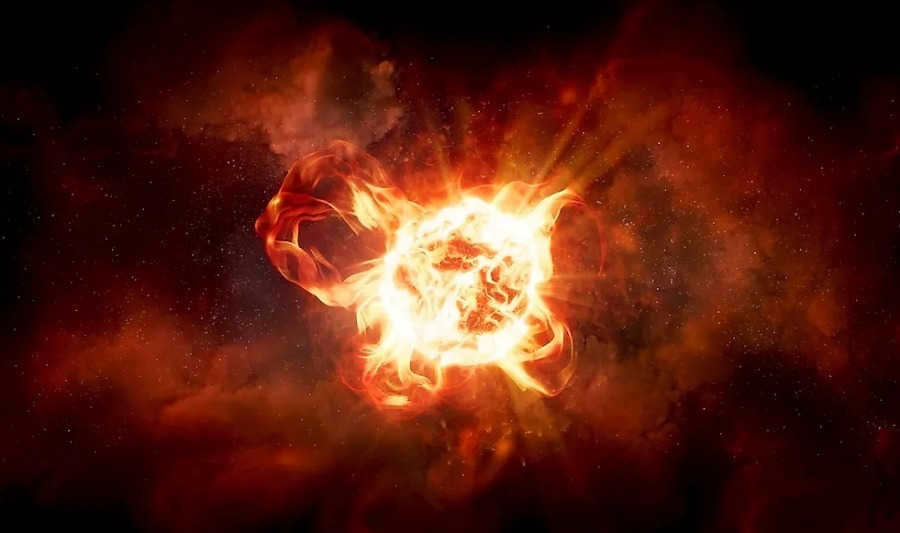
Red giants are a unique kind of stars that are in the last phase of their life cycle. It is noteworthy that each main-sequence star will transform into a red giant during a certain period of its existence, and the destiny of the star will ultimately depend on its mass.
Origin of red giants
Every star that undergoes nuclear fusion of hydrogen in its core is referred to as a main-sequence star. Even though stars contain vast quantities of hydrogen, the supply is finite and eventually depletes.
The fusion of hydrogen in the core of the star results in the production of helium, which accumulates in the core of the star. Once the star starts running out of hydrogen, the flow of nuclear energy outward begins to diminish, and the star’s immense gravitational force starts to cause it to collapse inward.
The star can shrink by up to 98%, and the intense compression leads to the fusion of hydrogen outside the core into helium. As a result, the hydrogen fusion zone moves away from the core, causing the core of the star to become hotter and denser.
Under these more extreme circumstances, the core of the star now has the ability to transform helium into heavier elements, liberating vast amounts of energy that counteract the gravitational force of the star and lead to its expansion.
A star has the potential to expand by hundreds of times its original size, and this expansion also results in the cooling of the outer layers of the star.
As a star expands, the temperature is spread across a larger surface area, causing the surface of the star to become cooler (5000 K, 4700 °C or lower) and giving the star its red color. This is the process by which it transforms into a red giant.
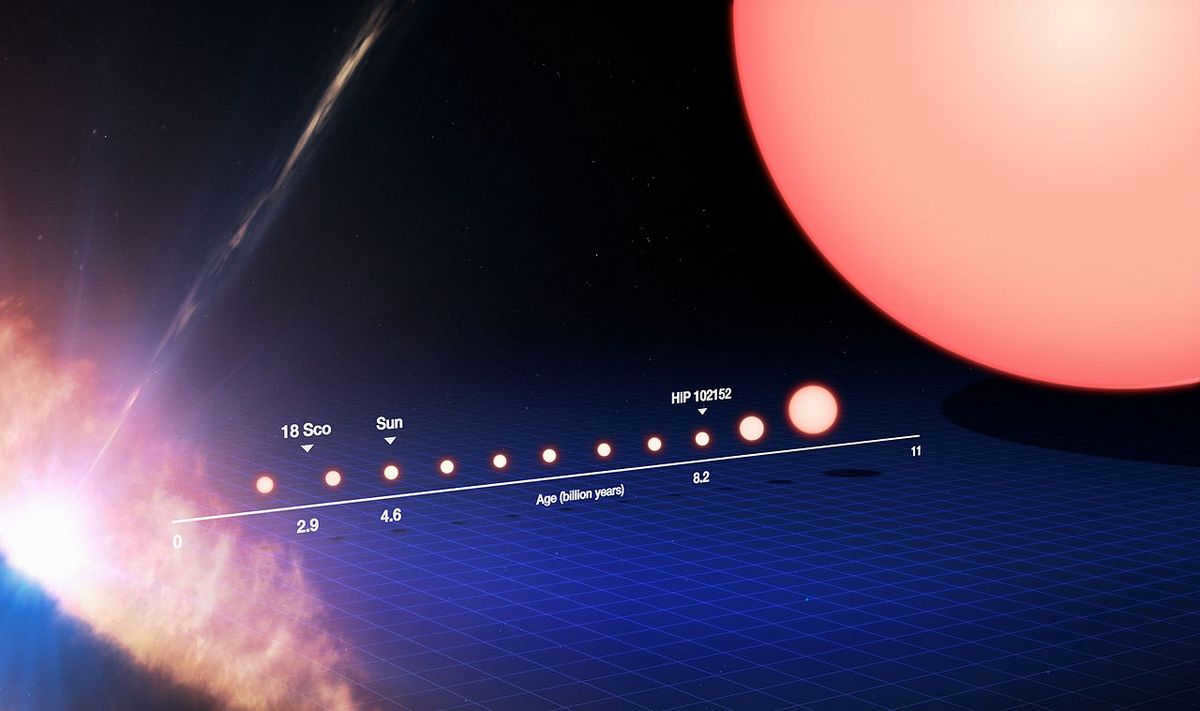
The Development of Red Giants
The progression of a red giant is primarily influenced by its mass. In the case of stars with low to intermediate masses (approximately 0.3-8 solar masses ( M ☉), the process of nuclear fusion usually halts at helium. As the red giant expands to an enormous size, the star’s gravitational force becomes insufficient to maintain its cohesion.
Over time, the energy radiating from the core collides with the outer layers of the star, creating a phenomenon referred to as a planetary nebula. For more massive stars, however, helium fusion triggers the accumulation of heavier elements like carbon and oxygen.
Iron is the initial element for which the energy required to create it exceeds the energy it releases. Hence, once iron starts to accumulate in the core of a star, its destiny is predetermined.
Iron absorbs the energy of the star, and inevitably, gravity takes control, leading to the inward collapse of the star. This collapse ultimately results in a massive explosion called a supernova, followed by the formation of a planetary nebula. Finally, the star transforms into a white dwarf, marking the end of its lifecycle.
Stars that avoid the red giant phase
Stars with very low mass have the ability to sustain the process of converting hydrogen into helium for an astonishing trillion years, until hydrogen makes up only a small portion of the star’s composition.
Throughout this period, both the luminosity and temperature gradually rise, similar to more massive main-sequence stars. However, as time goes on, the temperature eventually increases by approximately 50%, while the luminosity multiplies by a factor of about 10. Eventually, helium levels rise to a point where the star is no longer fully convective, and the remaining hydrogen trapped in the core is consumed within a few billion years.
Depending on the star’s mass, temperature and luminosity continue to rise for a while as the hydrogen shell burns out. The star may even become hotter than the Sun and tens of times brighter than its original state, although it will still be less luminous than the Sun.

